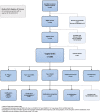Risk of obstetric anal sphincter injury associated with female genital mutilation/cutting and timing of deinfibulation
- PMID: 35946127
- PMCID: PMC9812199
- DOI: 10.1111/aogs.14424
Risk of obstetric anal sphincter injury associated with female genital mutilation/cutting and timing of deinfibulation
Abstract
Introduction: A greater risk of obstetric anal sphincter injury has been reported among African migrants in several host countries compared with the general population. To what degree female genital mutilation/cutting affects this risk is not clear. In infibulated women, deinfibulation prevents anal sphincter injury. Whether the timing of deinfibulation affects the risk, is unknown. This study aimed to investigate the risks of anal sphincter injury associated with female genital mutilation/cutting and timing of deinfibulation in Norway, and to compare the rates of anal sphincter injury in Somali-born women and the general population.
Material and methods: In a historical cohort study, nulliparous Somali-born women who had a vaginal birth in the period 1990-2014 were identified by the Medical Birth Registry of Norway and data collected from medical records. Exposures were female genital mutilation/cutting status and deinfibulation before labor, during labor or no deinfibulation. The main outcome was obstetric anal sphincter injuries.
Results: Rates of obstetric anal sphincter injury did not differ significantly by female genital mutilation/cutting status (type 1-2: 10.2%, type 3: 11.3%, none: 15.2% P = 0.17). The total rate of anal sphincter injury was 10.3% compared to 5.0% among nulliparous women in the general Norwegian population. Women who underwent deinfibulation during labor had a lower risk than women who underwent deinfibulation before labor (odds ratio 0.48, 95% confidence interval 0.27-0.86, P = 0.01).
Conclusions: The high rate of anal sphincter injury in Somali nulliparous women was not related to type of female genital mutilation/cutting. Deinfibulation during labor protected against anal sphincter injury, whereas deinfibulation before labor was associated with a doubled risk. Deinfibulation before labor should not be routinely recommended during pregnancy.
Keywords: Somalia; country of birth; female genital mutilation/cutting; migration; nulliparity; obstetric anal sphincter injury; timing of deinfibulation.
© 2022 The Authors. Acta Obstetricia et Gynecologica Scandinavica published by John Wiley & Sons Ltd on behalf of Nordic Federation of Societies of Obstetrics and Gynecology (NFOG).
Conflict of interest statement
The authors have stated explicitly that there are no conflicts of interest in connection with this article.
Figures




Similar articles
-
The effect of intrapartum deinfibulation on obstetric outcomes and postpartum sexual function in pregnant women with Type 3 Female Genital Mutilation/Cutting.Arch Gynecol Obstet. 2025 Apr;311(4):933-940. doi: 10.1007/s00404-024-07923-2. Epub 2025 Jan 25. Arch Gynecol Obstet. 2025. PMID: 39862269 Free PMC article.
-
Female genital mutilation/cutting, timing of deinfibulation, and risk of cesarean section.Acta Obstet Gynecol Scand. 2021 Apr;100(4):587-595. doi: 10.1111/aogs.14111. Epub 2021 Mar 14. Acta Obstet Gynecol Scand. 2021. PMID: 33719034
-
[Definition, epidemiology and risk factors of obstetric anal sphincter injuries: CNGOF Perineal Prevention and Protection in Obstetrics Guidelines].Gynecol Obstet Fertil Senol. 2018 Dec;46(12):913-921. doi: 10.1016/j.gofs.2018.10.028. Epub 2018 Oct 29. Gynecol Obstet Fertil Senol. 2018. PMID: 30385355 Review. French.
-
Maternal origin matters: Country of birth as a risk factor for obstetric anal sphincter injuries.Int J Gynaecol Obstet. 2024 Jul;166(1):426-434. doi: 10.1002/ijgo.15427. Epub 2024 Feb 15. Int J Gynaecol Obstet. 2024. PMID: 38358267
-
Views of female genital mutilation survivors, men and health-care professionals on timing of deinfibulation surgery and NHS service provision: qualitative FGM Sister Study.Health Technol Assess. 2023 Mar;27(3):1-113. doi: 10.3310/JHWE4771. Health Technol Assess. 2023. PMID: 36946235 Free PMC article.
Cited by
-
Comment on: "Health outcomes and female genital mutilation/cutting: how much is due to the cutting itself?".Int J Impot Res. 2023 May;35(3):228-230. doi: 10.1038/s41443-023-00667-8. Epub 2023 Feb 9. Int J Impot Res. 2023. PMID: 36759655 Free PMC article. No abstract available.
-
The effect of intrapartum deinfibulation on obstetric outcomes and postpartum sexual function in pregnant women with Type 3 Female Genital Mutilation/Cutting.Arch Gynecol Obstet. 2025 Apr;311(4):933-940. doi: 10.1007/s00404-024-07923-2. Epub 2025 Jan 25. Arch Gynecol Obstet. 2025. PMID: 39862269 Free PMC article.
-
Discerning Deinfibulation: Impact of Personal, Professional, and Familial Influences on Decision-Making.Qual Health Res. 2025 Feb;35(2):234-247. doi: 10.1177/10497323241257094. Epub 2024 Aug 8. Qual Health Res. 2025. PMID: 39116322
-
Female genital mutilation/cutting in women delivering in France: An observational national study.Int J Gynaecol Obstet. 2025 Feb;168(2):693-700. doi: 10.1002/ijgo.15880. Epub 2024 Aug 29. Int J Gynaecol Obstet. 2025. PMID: 39206525 Free PMC article.
References
-
- World Health Organization . Eliminating female genital mutilation. An interagency statement 2008 [Available from: https://www.who.int/reproductivehealth/publications/fgm/9789241596442/en/]
-
- Abdulcadir J, Rodriguez MI, Say L. Research gaps in the care of women with female genital mutilation: an analysis. BJOG. 2015;122:294‐303. - PubMed
-
- Balachandran AA, Duvalla S, Sultan AH, Thakar R. Are obstetric outcomes affected by female genital mutilation? Int Urogynecol J. 2018;29:339‐344. - PubMed

